Bergdala Spinnhus |
|
- About 4-shaft counterbalance looms (Scandinavian style) - About multi-shaft (dräll pulley) CB looms - About jämtlandsdräll - Thoughts about "overshot" - Some rag weave facts - Om vadmal - Om färgeffekt - About fabric analyis - bindningskonstruktion (opens in new window) - About construction of double layers - About weaving double width - Double width, part 2 - About profile patterns - How to expand a profile pattern - More about profile patterns - Om tagelvävning - About differential shrinkage - Solid colour? - Om datoriserad vävstol - About old wooden reeds - About reading old literature - About Hulda Peters vävbok - threading notations, part 1 - threading notations, part 2 - About horsehair - Tageltyg från Småland - ideas about displaying - "Original", kopia eller plagiat? - A survey of Swedish weaving books - Om tyst kunskap - Nog nu! in English: - Serial weaving - "TWILL" - Block substitution - Vadmal |
|
On differential shrinkage, and a tubular selvage |
|
|
By "differential shrinkage" we often mean what happens when we combine shrinking and non-shrinking yarns in one woven piece.
We often think that we can predict the results.
Sometimes that is correct. Sometimes it turns out that there are a good many more parameters than that...
For some time I have been making bumpy shawls using warp and weft stripes of a shinking yarn (wool) between wider warp and weft stripes of a non-shrinking yarn (cotton and/or linen and/or silk).
|
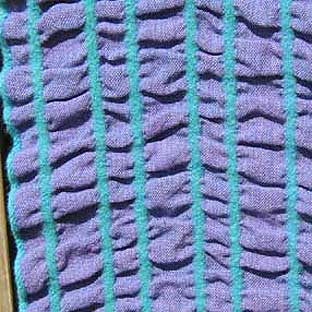
|
||
|
This is what I found:
|
|||
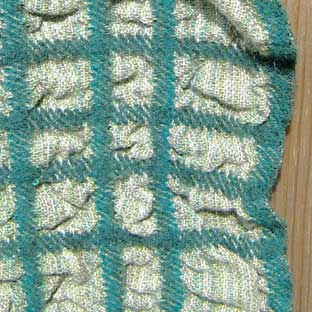
|
When there was a wool stripe at the selvedge, that stripe often shrunk less than the inner stripes. A slightly wider outer stripe seemed to shrink more than a narrower, but it was still often longer.
To begin with, I did not find this a problem - the whole shawl was bumpy and wavy anyway, so why worry? |
||
|
This is the original draft I used:
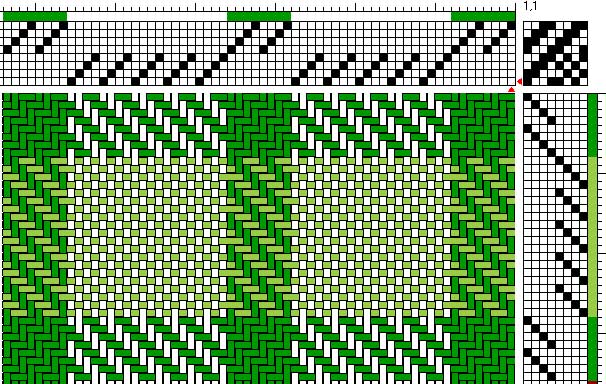
While still not seeing it as a problem, I wanted to investigate the phenomenon. The edge stripe acted as if there were more interlacements in it, compared to the inner stripes. This was, technically, not true. Except... the weft turned around the very outer yarn. Could it be this turn that trapped the wool yarn, preventing it from shrinking?
So... what would happen if I tried a tubular edge? After some experiments, I have come to use this draft instead: 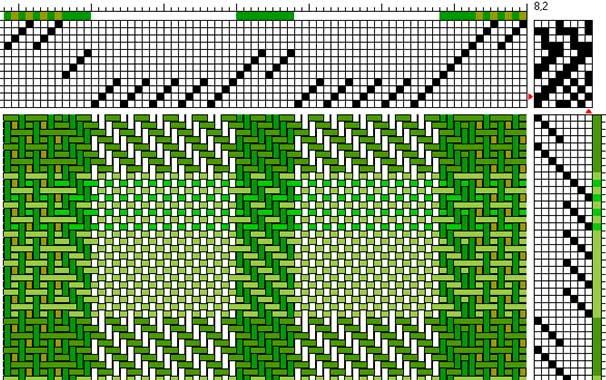
(Green warp is wool - the different green colours are ONLY a way to make the reading of the structure easier! White warp is the non-shrinking cotton, linen, silk...
Dark green weft is wool, light green is the non-shrinking yarn - the first eight picks have different colours ONLY as a way to make the reading of the structure easier!) If you examine the draft, you can see that the outer 8 warp ends form double layers in plain weave. Be careful NOT to tighten the weft too much - it may look sleazy, but the wet finishing and shrinkage will remedy that. This threading gives a much more consistent shrinking of all the stripes. |
|||
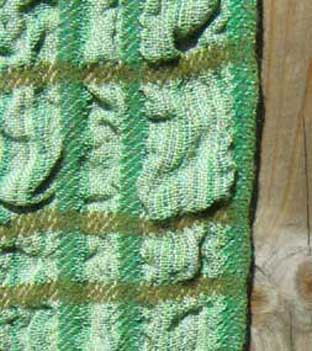
|

|
||
|
So... how much shrinkage is "right"?
That is, as so often, a matter of personal taste.
|
|||
|
... but the selvage don't have to be shrinking. Here is another idea:
For this shawl I used a darkish blue cotton for one "ruffle", a lightish blue for the other and a purple wool for the shrinking stripe.
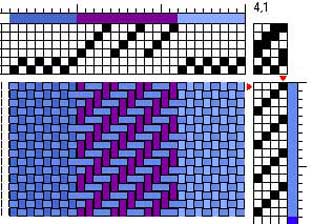
See more "shrunk" ideas here.
|
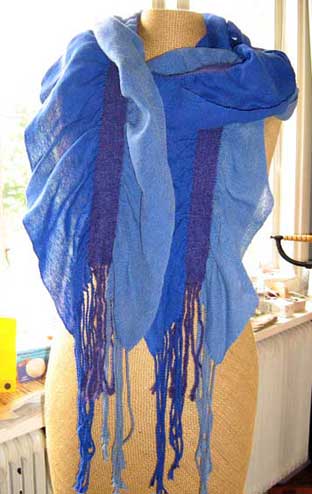
|
||